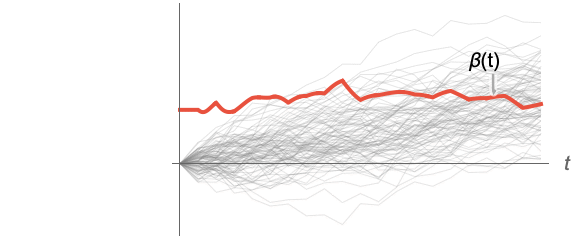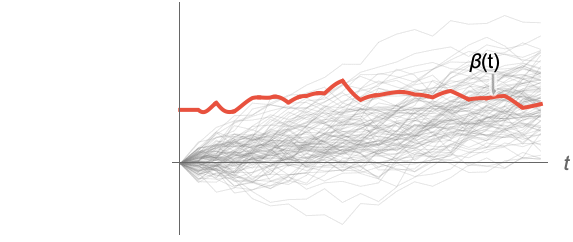

Kurtosis
Details


- Kurtosis measures the concentration of data around the peak and in the tails versus the concentration in the flanks.
- Kurtosis[…] is equivalent to CentralMoment[…,4]/CentralMoment[…,2]2.
- A normal distribution has kurtosis
 equal to 3. In comparing shapes with normal we have:
equal to 3. In comparing shapes with normal we have: -

more flat than normal, platykurtic 
like normal, mesokurtic 
more peaked than normal, leptokurtic - Kurtosis[{{x1,y1,…},{x2,y2,…},…}] gives {Kurtosis[{x1,x2,…}],Kurtosis[{y1,y2,…}],…}.
- Kurtosis handles both numerical and symbolic data.
- The data can have the following additional forms and interpretations:
-
Association the values (the keys are ignored) » SparseArray as an array, equivalent to Normal[data] » QuantityArray quantities as an array » WeightedData weighted mean, based on the underlying EmpiricalDistribution » EventData based on the underlying SurvivalDistribution » TimeSeries, TemporalData, … vector or array of values (the time stamps ignored) » Image,Image3D RGB channel's values or grayscale intensity value » Audio amplitude values of all channels » DateObject, TimeObject list of dates or list of times - For a random process proc, the kurtosis function can be computed for slice distribution at time t, SliceDistribution[proc,t], as β[t]=Kurtosis[SliceDistribution[proc,t]]. »


Examples
open all close allBasic Examples (4)
Scope (23)
Basic Uses (7)
Exact input yields exact output:
Approximate input yields approximate output:
Find the kurtosis of WeightedData:
Find the kurtosis of EventData:
Find the kurtosis of TemporalData:
Find the kurtosis of TimeSeries:
Array Data (5)
Kurtosis for a matrix gives columnwise kurtosis:
When the input is an Association, Kurtosis works on its values:
SparseArray data can be used just like dense arrays:
Find the kurtosis of a QuantityArray:
Image and Audio Data (2)
Channelwise kurtosis value of an RGB image:
Mean intensity value of a grayscale image:
On audio objects, Kurtosis works channelwise:
Date and Time (5)
Distributions and Processes (4)
Find the kurtosis for univariate distributions:
Kurtosis for derived distributions:
Applications (6)
Normal distributions have Kurtosis value 3:
Leptokurtic distributions have kurtosis greater than 3:
Platykurtic distributions have kurtosis less than 3:
The limiting distribution for BinomialDistribution as ![]() is normal:
is normal:
The limiting value of the kurtosis is 3:
By the central limit theorem, kurtosis of normalized sums of random variables will converge to 3:
Define a Pearson distribution with zero mean and unit variance, parameterized by skewness and kurtosis:
Obtain parameter inequalities for Pearson types 1, 4, and 6:
The region plot for Pearson types depending on the values of skewness and kurtosis:
Generate a random sample from a ParetoDistribution:
Determine the type of PearsonDistribution with moments matching the sample moments:
This time series contains the number of steps taken daily by a person during a period of five months:
Analyze the kurtosis as an indication of consistency of daily steps taken:
The histogram of the frequency of daily counts shows that distribution is mesokurtic:
Find the skewness for the heights of the children in a class:
Kurtosis larger than 3 would indicate a distribution highly concentrated around the mean:
Properties & Relations (5)
Kurtosis for data can be computed from CentralMoment:
Kurtosis for a distribution can be computed from CentralMoment:
Kurtosis is bounded from below by 1, as ![]() :
:
Normal distributions have Kurtosis value 3:
Approximately normal distributions have Kurtosis values near 3:
Possible Issues (2)
Kurtosis coefficient is sometimes confused with excess kurtosis coefficient:
The excess kurtosis vanishes for NormalDistribution:
Excess kurtosis is defined as Cumulant[dist,4]/Cumulant[dist,2]^2:
Neat Examples (1)
The distribution of Kurtosis estimates for 20, 100, and 300 samples:
Tech Notes
Text
Wolfram Research (2007), Kurtosis, Wolfram Language function, https://reference.wolfram.com/language/ref/Kurtosis.html (updated 2024).
CMS
Wolfram Language. 2007. "Kurtosis." Wolfram Language & System Documentation Center. Wolfram Research. Last Modified 2024. https://reference.wolfram.com/language/ref/Kurtosis.html.
APA
Wolfram Language. (2007). Kurtosis. Wolfram Language & System Documentation Center. Retrieved from https://reference.wolfram.com/language/ref/Kurtosis.html
BibTeX
@misc{reference.wolfram_2025_kurtosis, author="Wolfram Research", title="{Kurtosis}", year="2024", howpublished="\url{https://reference.wolfram.com/language/ref/Kurtosis.html}", note=[Accessed: 14-December-2025]}
BibLaTeX
@online{reference.wolfram_2025_kurtosis, organization={Wolfram Research}, title={Kurtosis}, year={2024}, url={https://reference.wolfram.com/language/ref/Kurtosis.html}, note=[Accessed: 14-December-2025]}